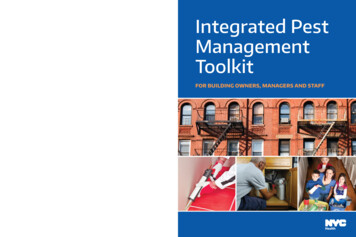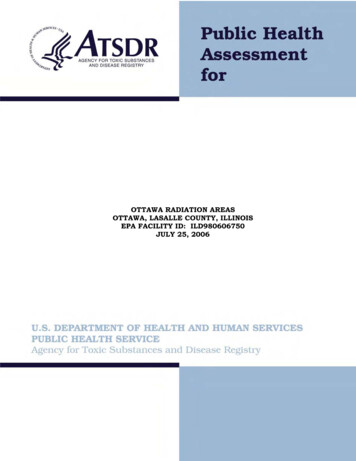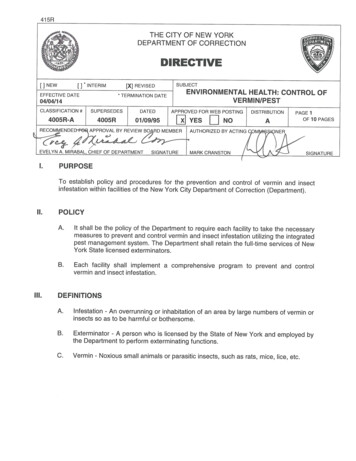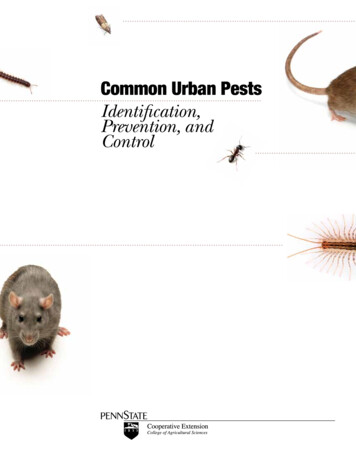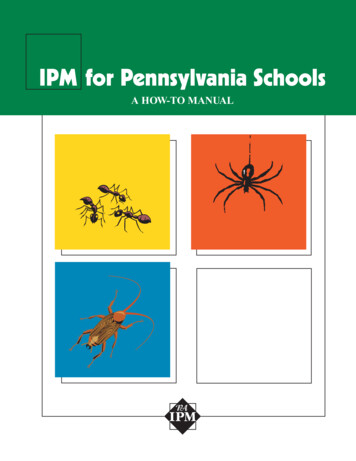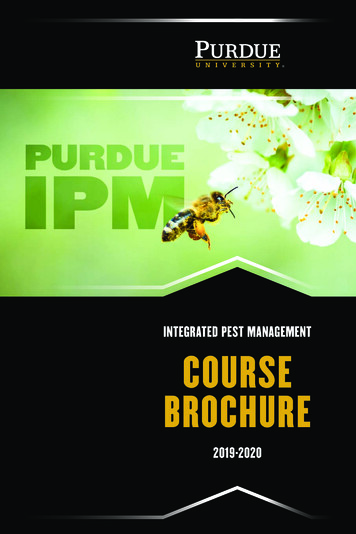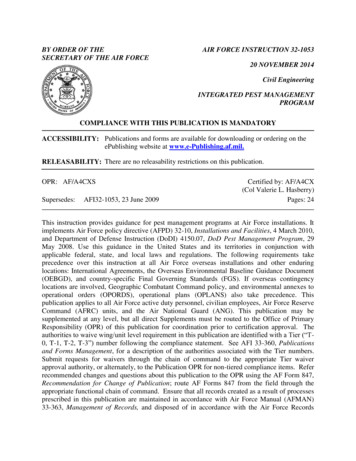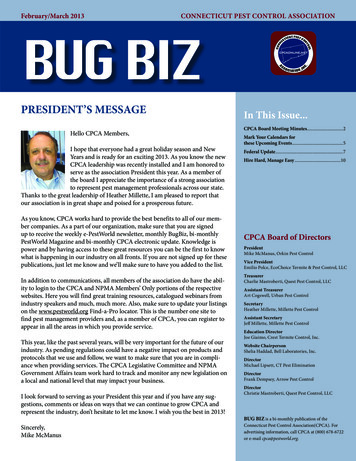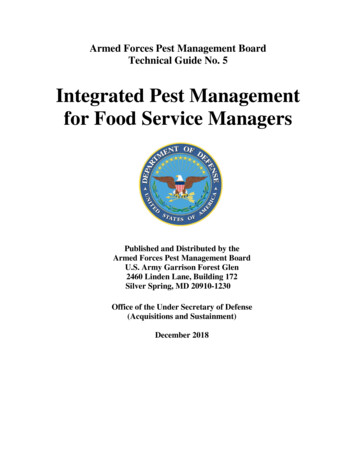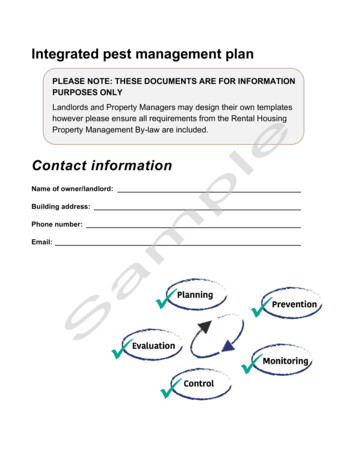
Transcription
Integrated pest management planPLEASE NOTE: THESE DOCUMENTS ARE FOR INFORMATIONPURPOSES ONLYLandlords and Property Managers may design their own templateshowever please ensure all requirements from the Rental HousingProperty Management By-law are included.Contact informationName of owner/landlord:Building address:Phone number:Email:
IntroductionWhat is integrated pest management?An integrated pest management plan is a multi-step process to manage pests and infestationsthat includes planning, prevention, monitoring, pest control and evaluation. There is a role forboth the landlord and the tenant in effective integrated pest management.Responsibilities[List any additional responsibilities for managing, preventing and treating pests for tenants andlandlords in this section]Landlord responsibilitiesUnder the City of Ottawa’s Rental Housing Property Management By-law (No. 2020-255),landlords are responsible for the following with regards to pest management: Establish and maintain an integrated pest management plan for a rental property. Thefollowing must be included in the document:o Schedule of preventative inspections that is reasonable for the age and conditionof each rental property.o Educational information about the prevention of infestations made available totenants.o Reporting processes for suspected infestations.o Standing pest treatment plans to be applied in the event of an infestation of bedbugs, cockroaches, ants, rats, mice, and any species known to cause reoccurring infestations at the given property.Provide tenants with a copy of a pest treatment plan prior to treating an infestationwithin their unit.Post notice of a pest treatment plan in the lobby of an apartment building when thetreatment is in a building area accessible to tenants other than a rental unit.Re-inspect area treated for pests between 15 to 30 days following completion oftreatment.Submit a copy of the integrated pest management plan and standing pest treatmentplan to a by-law officer when requested.According to the Residential Tenancies Act, 2006, the Province of Ontario states that landlordsare responsible for the following with regards to pest management:2
A landlord must keep the rental property clean. This includes the lobby, halls, elevator,laundry room, pool, and parking lot or garage. A landlord must also take steps to controlpests such as cockroaches and mice.A residential complex shall be kept reasonably free of rodents, vermin and insects.O. Reg. 517/06, s. 46 (1).The methods used for exterminating rodents and insects shall be in accordance withapplicable municipal or provincial law. O. Reg. 517/06, s. 46 (2).Openings and holes in a building containing one or more rental units shall be screenedor sealed to prevent the entry of rodents, vermin, insects and other pests. O. Reg.517/06, s. 46 (3).Accommodate tenants with disabilities, as necessary, when treating or inspecting theirunits for pest infestations.Tenant responsibilitiesUnder the City of Ottawa’s Rental Housing Property Management By-law (No. 2020-255),tenants are responsible for the following with regards to pest management: Submit a tenant service request to report an infestation, suspected infestation, orconditions likely to cause an infestation.Do not cause conditions which may attract or harbor pests.Treat infestation of fleas, lice, or ticks on pets.Follow pest treatment plans prepared by landlords.According to the Residential Tenancies Act, 2006, the Province of Ontario states that tenantsare responsible for the following with regards to pest management: A tenant must keep their rental unit clean, up to the standard that most people wouldconsider ordinary or normal cleanliness.Promptly notify the landlord if there is a pest problemCooperate with the landlord in fixing the problem by preparing their unit for treatmentand cleaning or discarding any of their belongings that have pests, if necessary.Allow access to units upon receiving written notice 24 hours in advance or if tenantagrees to let them in for inspection or treatment of pests.In the event of an infestation, you can request of your landlord that certain pesticides beavoided however, if this request is refused by the landlord, you must allow the treatmentto occur.3
1.PreventionBuilding inspection schedule[Create and update a schedule of preventative inspections reasonable to the condition and age of the rental propertyand consider using format below]Rental property address:Area ofbuildinginspectedCompleted byResultsActiontakenDate andtimeinspected4NextscheduledinspectionAdditional comments
Building inspection instructions[Enter instructions for whomever is inspecting, where to inspect, what to look for includingsigns of infestations and openings/screens/cracks]1. Inspect all common areas for pests or pest activitya. Hallwaysb. Garbage Chute roomsc. Laundry roomsd. Electrical roomse. Storage/locker roomsf. Mechanical roomg. Bathroomsh. Community kitchensi. Loungesj. Parking garage2. Complete attached table for each area inspected3. Where pest activity is suspected:a. Place monitors for tracking purposesb. Schedule follow up inspection4. Where pest activity is found:a. Place monitors for tracking purposesb. Apply bait and dustc. Post notice in lobbyd. Schedule follow up inspection5
Individual unit inspection schedule[Create and update a schedule of preventative inspections reasonable to the condition and age of the rental propertyand consider using format below]Address Pest Level ofPestResultsType Infestation controltaskcompletedDate andtimeinspected6InspectedbyFollow up date(if applicable)Nextscheduledinspection
Individual unit inspection instructions[Enter instructions for whomever is inspecting, where to inspect, what to look for includingsigns of infestations and openings/screens/cracks]1. Inspect each unit for pest activity2. If tenant is home, speak to them about current or past pest issues3. Kitchen inspection:a. inside cupboardsb. under cabinetsc. behind large appliancesd. under small appliances4. Living room inspection:a. Under cushionsb. In cracks of furniturec. Around baseboardsd. Near exterior doors5. Bedroom inspection:a. Under pillowsb. Below mattress and box springc. Along bedframed. Around baseboardse. Around base of dresser or side table6. Bathroom:a. Under sinkb. Inside vanity7. Where pests are suspected:a. Place monitors for tracking purposesb. Schedule follow up inspection8. Where pests are found:a. Provide tenant with standard treatment planb. Schedule follow up for treatment7
2.Education[This section is to include any information regarding pests for tenants]Bed bugsBed bugs are small, brownish insects with oval-shaped bodies about the size of an apple seed.Bed bugs feed on human blood, usually at night however they are not known to spreaddiseases. Bed bugs can be brought into your home in your suitcase after travelling, on usedfurniture, or used clothing.Bed bugs can be found on beds, mattresses, side tables, headboards, under baseboards, in orbehind picture frames, in clothes, and on furniture.The bites can result in skin rashes, psychological effects, and allergic symptoms. Symptoms ofa bed bug bite can take minutes to days to appear. Itchiness is often, but not always, present.Bed bug bites are typically visible on skin which is exposed during sleep such as the hands,neck, face, shoulders, arms and legs.Bed bug eggs and juvenile bed bugs are small and difficult to see. However, adult bed bugsare detectable with the naked eye and can be found grouped together in a small area in a lineor zig zag pattern on the mattress or within the seams of a mattress. Bed bugs are also knownto enter cracks and crevices of furniture.8
Preventing and treating bed bugsTo help prevent bed bugs, tenants can take the following steps: Carefully check used furniture, beds and couches for any signs of bed bug infestationsprior to bringing them into your home. Avoid taking home mattresses or sofas put outon curbside. If you see brown spotting on mattress or furniture, this is most likely bedbug feces, therefore please contact your landlord immediately.Reduce clutter in your home to reduce hiding places for bed bugs.Move beds away from the wall to create an “island”, preventing bedbugs from travelingup the wall and onto the bed.Use protective mattress and box spring covers to limit the potential hiding spots for bedbugs to enter.Keep your bed and box spring off the floor, preferably on a metal bedframe.Keep your rental unit clean and vacuum frequently, especially under and behind beds.Seal cracks and crevices around wooden bed frames, furniture, and light sockets todiscourage potential bed bug movement.Check your home regularly for bed begs. If you find signs of bed bugs, notify yourlandlord immediately.While travelling, do not bring your own pillows, and inspect the bed, mattress,headboard, dressers, and side tables where you are staying prior to bringing yourluggage onto the premises. When you return, place your luggage on a hard surfaceaway from places bed bugs could crawl to and hide. Wash your clothing and fabricitems in hot water and dry in the dryer on the highest heat.If you are a tenant and you have a problem with bed bugs, you should notify your landlord,superintendent or property manager immediately. Bed bugs can be identified and controlledusing a licensed pest control company. You can also vacuum, steam clean, or dry clothes athigh temperatures, and reduce clutter in your home to assist with the treatment of bed bugs.You must also cooperate with your landlord with pest control and follow pest treatment plans.ReferencesThe above information was sourced from the following references: How to Identify and Remove Bed Bugs Orkin (www.orkin.com/other/bed-bugs) Bed Bugs - Ottawa Public Health (www.ottawapublichealth.ca) Bedbugs: how do I get rid of them? - Canada.ca (www.canada.ca)9
CockroachesThe average fully-grown cockroach has a flattened brown oval body with long spiny legs andmeasures 15mm in length. Although there are many different types of cockroaches, theGerman cockroach is one of the most common household cockroaches. They are tan to lightbrown, with two dark parallel streaks running from the head to the base of the wing.Cockroaches have wings but are unable to fly. Cockroaches can contaminate food and spreaddisease by walking over, and excreting on, food or food preparation areas after havingtravelled through garbage and/or sewers. They are attracted to warm, damp conditions suchas kitchens, bathrooms, basements, and plumbing areas. Cockroaches and their egg casescan be brought into your home on various objects such as groceries, rugs, used furniture andappliances, empty bottles, some bulk foods, and shipping cartons. Cockroaches are mostactive at night and are attracted to food sources that contain starches, sugars, and protein.Preventing and treating cockroachesKeeping a clean home is a crucial step in preventing cockroaches. Since cockroaches areattracted to food and water, the Government of Canada recommends the following cleaningprotocols to prevent cockroaches.For tenants: Reduce clutter in your home to reduce hiding places for cockroaches.Clean up spills immediately and do not leave pet water and food out 24 hours a day.Keep food in tightly sealed plastic or glass containers rather than in paper or cardboardthat roaches can chew through and lay eggs in.Regularly clean dark and/or damp areas close to a food source (for example beneath10
and behind appliances).Store garbage in sealed plastic containers and dispose of it daily.Do not allow dirty dishes to pile up, especially overnight. If you cannot wash themimmediately, leave them to soak in detergent and water.Vacuum often to help remove food particles and insect egg masses.Ventilate bathrooms and dehumidify moist areas to reduce sources of water.Landlords can help avoid cockroaches by: Insulating water pipes that are subject to excess condensation.Repairing leaky faucets and pipes.Sealing all cracks, crevices, and pipe openings to reduce cockroach hiding places.If you have cockroaches, contact your landlord immediately. Here are some ways to treatcockroaches: Keep your home clean.Steam clean furniture, toys or crafts. For items you cannot steam clean, freeze infesteditems for at least 24 hours to 1 week.Vacuum regularly to remove food sources, cockroaches, and their egg cases. Placeyour vacuum bag in soapy water to ensure the pests are all destroyed after vacuuming.Dispose of vacuum bag in an outside garbage bin, if possible.Buy or build cockroach traps.Consider hiring a professional pest exterminator.ReferencesThe above information was sourced from the following references: Cockroaches - Canada.ca Cockroaches - Ottawa Public Health Cockroaches Facts & Identification, Control & Prevention (orkincanada.ca)11
AntsAnts are tiny insects that can vary in colour from black, brown, red, or yellow. Carpenter antsare a larger type of ant, which can be measured up to 12.mm.Preventing and treating antsAccording to the Government of Canada, removing access to food and water is the easiestway to avoid pest problems: Store ant-attractive foods in glass jars with rubber gaskets, or in plastic containers withlids that snap tight.Keep kitchen countertops clean. Sweep or vacuum the floor often, especially around petdishes.Rinse containers before putting them in the garbage or in recycling bins.Empty kitchen garbage containers often.Place composters at a reasonable distance from your house.Place pet food dishes in a shallow dish of water. Ants can't swim, so they won't be ableto get at your pet's food.Ants will not cross sticky barriers. Try placing two-sided tape around the legs of plantstands.Flood ant nests repeatedly with a garden hose to encourage the ants to move fartheraway from your house.Pour boiling water and detergent down the nest to temporarily reduce the population ofa colony.12
Landlords can help avoid ants by: Repair and seal as many visible cracks in the foundation and exterior walls of the houseas possible.Caulk along baseboards, cracks, and crevices to keep ants from passing through yourhouse. If needed, use duct tape or petroleum jelly to temporarily seal cracks.Consider hiring a professional exterminator that can use chemical products to treat for ants.Non-chemical products and bait systems may also be used to treat ants.ReferencesThe above information was sourced from the following references: Ants - Canada.ca Ant Types & Facts How to Get Rid of Ants OrkinRats and miceThe house mouse has large ears and is light brown to dark grey. Rats are larger than mice andcan weight up to 1 pound. Rats and mice are both known to be carriers of disease and candamage property.Preventing and treating rats and miceScratching sounds in the walls of your home, signs of gnawing or chewing, damaged foodpackages, signs of droppings and urine, burrows or holes in and around foundation walls canbe a good predictor that you have an infestation of mice or rats. Notify your landlordimmediately if you suspect there is a rat or mouse infestation.If rats and mice are present in a rented home, there are several options for control that tenantscan use: Make their home less attractive to rodents by removing clutter and garbage around the13
house and sealing garbage containers to keep rats and mice out of them.Garbage within the home should be kept in a container with a sealed lid.Traps such as the snap traps and electronic traps are easy to use and effective. Livetraps are also effective and are triggered when rats or mice walk over them.Ultrasonic devices that give off sound waves or vibrations that rodents dislike. However,please keep in mind that the rats and mice may adapt to the device and return. It isrecommended to use devices along with other pest control options.Consider hiring a professional pest exterminator.Prevention is a key component of controlling rodent problems in your home. Here are somepreventative tips that a landlord can implement to eliminate rodents: Ensuring all cracks are sealed on the exterior of the rental home.Hire a professional pest exterminator.ReferencesThe above information was sourced from the following references: Rat Control - Ottawa Public HealthRats and mice - Canada.caCommon Types of Rodents Remove Rats & Mice Orkin[Name of pest][Provide additional pest information for your tenants specific to your rental property, ifapplicable.]14
3.ReportingSubmitting a pest service request[Provide information on reporting processes for suspected pest infestations which align withthe tenant service request requirement in the Rental Property Housing By-law]How to submit a service request[Enter steps for tenants to follow in order to submit a service request related to pests]Reinspection requirements[Enter information regarding obligations to re-inspect areas within 15 – 30 days wheretreatment has been undertaken]15
4.TreatmentThe Rental Property Management By-law requires that landlords include standing treatmentplans for bedbugs, cockroaches, ants, rats, mice and any other pest known to causeinfestations in the rental property. These treatment plans must be applied in the event ofinfestations. See below an example of a treatment plan for bedbugs provided by OttawaCommunity Housing.Treatment plan for bedbugs[Create a standing treatment plan for any pests that is specific to your rental property. Anexample of a Standing Treatment Plan for bed bugs can be found below]Standing Treatment Plan- Bedbug ResponseSAMPLE**This is a template created by Ottawa Community Housing and shall be used forinformational purposes only**Bedbug Standard Treatment PlanInitial Visit:Inspection Vacuum Mattress Encasemento Number installed Moatso Number installed16
SteamFollow up treatment: yes NoDate:Inspection Vacuum Steam Mattress Encasemento Number installed Moatso Number installed Chemical treatment (all humans and all pets must leave home for minimum 4 hours)o Product appliedo Quantity appliedTenant Responsibility for follow up Pick up clothing and other loose items from floor Remove all sheets, covers, duvets, pillows or other bedding from your beds. Theseshould be placed in dryer for 40 minutes on high cycle. Remove all garbage from the home Declutter to remove potential bedbug harborages Move all furniture away from wall to allow access to baseboards Vacuum baseboards to remove dust and debris Other:Technician Name:Date of visit:Notice of entry and additional treatment planNotice of Entry and Treatment PlanSAMPLE**This is a template created by EOLO and shall be used for informational purposesonly**17
NOTICE OF ENTRY& TREATMENT PLAN(NORMAL PREPARATION)Dear resident(s) ofOn (date) , between (time) and , a staffperson or pest control operator will enter your unit to treat the unit for (name of pest)by one of more of the following means: vacuuming, steam cleaning, apesticide spray, Gel treatments and/or residual dust (using products approved by HealthCanada). Pest monitors may be left in your unit.INSTRUCTIONS TO YOU ARE ATTACHED. PLEASE BEGIN THE PREPARATION WORKAS SOON AS POSSIBLE, because much of the preparation needs to be done BEFORETHE TREATMENT to eliminate the pests.YOU ARE REQUIRED TO ABIDE BY THE ATTACHED INSTRUCTIONS, AND THEINSTRUCTIONS BELOW. IF YOU FAIL TO FOLLOW THE INSTRUCTIONS, that caneasily result in the failure of the pest treatment, and/or your committing an offence under section 37 of the City of Ottawa’s RentalHousing Property Management By-law.HERE ARE FURTHER INSTRUCTIONS (in addition to the attached instructions):FOR THE TREATMENT DAY:2. Ensure all pets are under control or are caged.3. Put away any valuables.4. Be ready to stay away from the unit (with your pets) for 6 hours after the visit if necessary.AFTER THE TREATMENT:5. If any treatment products, or residue or dust are left behind, DO NOT CLEAN THEM UPUNTIL AFTER WE INSPECT AGAIN IN 15 TO 30 DAYS.6. If any pest traps or monitors are left after the visit, do not interfere with them in any way.18
After the treatment, we will contact you to schedule a follow up inspection, or another full pesttreatment. If a further treatment is needed, more instructions will follow.If you have any questions, contact .NOTICE OF ENTRY& TREATMENT PLAN(MINIMAL PREPARATION)Dear resident(s) ofOn (date) between (time) and , a staff person or pestcontrol operator will enter your unit to inspect the unit for (name of pest)After the inspection, the staff person or pest control operator MAY treat parts of the unit by oneof more of the following means: vacuuming, steam cleaning, a pesticide spray, Gel treatmentsand/or residual dust (using products approved by Health Canada). Pest monitors may be left inyour unit.INSTRUCTIONS TO YOUFOR THE INSPECTION/TREATMENT DAY:1.Without moving any more items than you have to move, please make sure the staff personor pest control operator can access the room and area where you think the pests are located.2. Ensure all pets are under control or are caged.3. Put away any valuables.4. Be ready to stay away from the unit (with your pets) for 6 hours after the visit if necessary.AFTER THE INSPECTION/TREATMENT DAY:5. If any treatment products, (such as residue, gels or dust) are left behind, DO NOT CLEANTHEM UP UNTIL AFTER WE INSPECT AGAIN IN ABOUT 15 TO 30 DAYS.6. If any pest traps or monitors are left after the visit, do not interfere with them in any way.YOU ARE REQUIRED TO ABIDE BY THE ATTACHED INSTRUCTIONS, AND THEINSTRUCTIONS BELOW. IF YOU FAIL TO FOLLOW THE INSTRUCTIONS, that caneasily result in19
the failure of the pest treatment and/oryour committing an offence under section 37 of the City of Ottawa’s RentalHousing Property Management By-law.After the inspection or treatment, we will contact you again to tell you the result of theinspection, or to schedule a follow up inspection, or a full pest treatment. If a further treatmentis needed, more instructions will follow.If you have any questions, contact .NOTICE OF ENTRY& TREATMENT PLAN(INSPECTION AND POSSIBLE NON PESTICIDE TREATMENT ONLY)Dear resident(s) ofOn (date) , between (time) and , a staffperson or pest control operator will enter your unit to inspect the unit for (type of pests)After the inspection, the staff person or pest control operator MAY treat parts of the unit by oneof more of the following means: vacuuming, steam cleaning, Gel treatments and/or residualdust (using products approved by Health Canada). Pest monitors may be left in your unit.INSTRUCTIONS TO YOUFOR THE INSPECTION/TREATMENT DAY:1.Without moving any more items than you have to move, please make sure the staff personor pest control operator can access the room and area where you think the pest are located.2. Ensure all pets are under control or are caged.3. Put away any valuables.AFTER THE INSPECTION/TREATMENT DAY:4. If any treatment products (such as residue, gels or dust) are left behind, DO NOT CLEANTHEM UP UNTIL AFTER WE INSPECT AGAIN IN ABOUT 15 TO 30 DAYS.5. If any pest traps or monitors are left after the visit, do not interfere with them in any way.20
After the inspection or treatment, we will contact you again to tell you the result of theinspection, or to schedule a follow up inspection, or a full pest treatment. If a further treatmentis needed, more instructions will follow.If you have any questions, contact .[Create a separate standing treatment plan for cockroaches, ants, rats and mice, and anyother pest specific to your rental unit. An example of a Standing Treatment Plan for bed bugscan be found above]Treatment plan for cockroachesTreatment plan for antsTreatment plan for rats and miceTreatment plan for other pests specific to your property21
Post notice of a pest treatment plan in the lobby of an apartment building when the treatment is in a building area accessible to tenants other than a rental unit. Re-inspect area treated for pests between 15 to 30 days following completion of treatment. Submit a copy of the integrated pest management plan and standing pest treatment
